
Farmers are being asked to check for middens – tennis ball-sized plugs constructed by earthworms – when monitoring their soil.
New research led by SRUC has found these plugs made of straw, plant debris and stones cover up to 42% of the soil surface in regenerative farm fields.
Importantly, these ‘middened’ patches – the area underlying the middens – are biological hotspots with high earthworm densities and very biologically active and porous soil.
Middens, which are built by Lumbricus terrestris earthworms to plug their vertical burrows, are more common in areas where conservation agriculture and regenerative practices such as no-tillage soil management are used.
Lead researcher Jackie Stroud, at SRUC, encouraged farmers and landowners to take part in the next midden survey.
“We would recommend that during soil monitoring, farmers check for the presence of middens to avoid underestimating biodiversity and misunderstanding soil health.”
Further research has found that these earthworms choose pathogen-infected straw to construct their middens, which has implications for reducing pesticide use and improving crop disease management.
Researchers at SRUC are now looking for volunteers to take part in the next midden survey.
